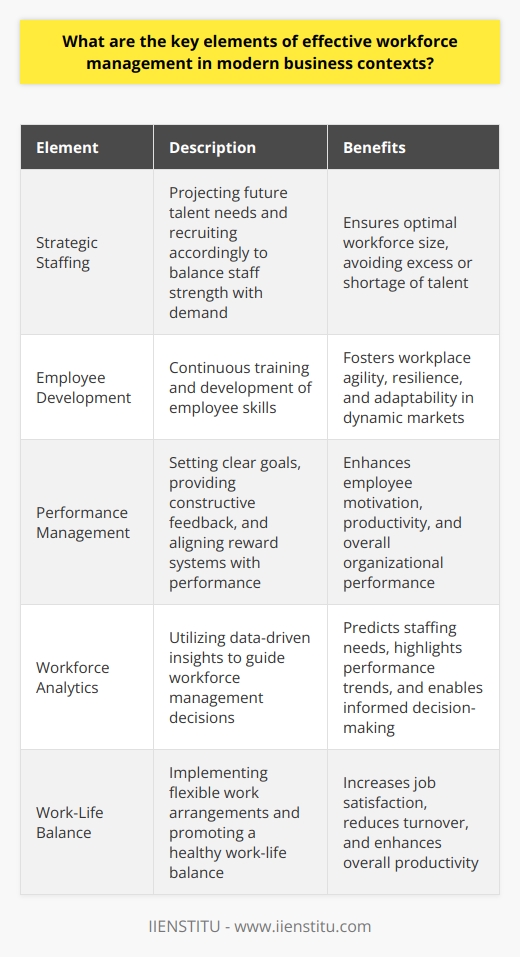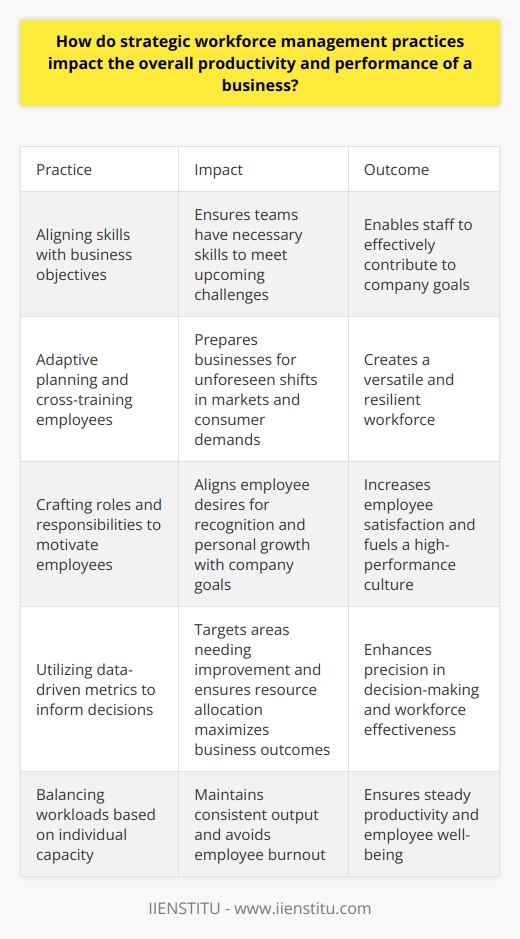
In today's rapidly evolving business landscape, the meticulous coordination of workforce management stands paramount among strategies for organizational success. It is a multifaceted discipline that extends beyond mere personnel administration, encapsulating a strategic framework vital for optimizing employee productivity and sustaining competitive advantage. Effective workforce management strategies are crucial for businesses to thrive in an increasingly complex and dynamic environment.
As a seasoned HR professional with over a decade of experience, I have witnessed firsthand the transformative power of well-executed workforce management. In one particularly memorable instance, our organization was grappling with high turnover rates and declining productivity. By implementing a comprehensive workforce management plan that focused on employee engagement, skill development, and flexible scheduling, we were able to turn the tide. Within a year, our turnover rates had decreased by 35%, and productivity had soared, leading to a significant boost in our bottom line.
In this article, we seek to explicate the essence of workforce management, elucidate its indispensable role within modern businesses, and explore a compendium of strategies and challenges inherent in its practice. This exploration is designed to offer a compendious yet deep understanding of workforce management's critical nature. With the integration of examples from various industries, we aim to provide both novices and seasoned professionals with insights that amplify the practical application of workforce management principles in their respective organizational settings.
Understanding Workforce Management
Enhancing productivity: Effective workforce management ensures that each employee's skills and efforts are harnessed optimally, thus streamlining operations and heightening organizational productivity.
Reducing labor expenses: By aligning staff levels precisely with business needs, workforce management helps in curtailing unnecessary labor costs, thereby optimizing the employment of financial resources.
Ensuring regulatory compliance: It also plays a critical role in averting legal challenges by maintaining adherence to employment laws and labor standards, thereby mitigating risks and safeguarding the organization's reputation.
Definition and Explanation of Workforce Management
Workforce management is an organizational process that maximizes performance levels and competency for an organization. At its core, it involves the harmonious alignment of a company's needs with its employees, ensuring that the right number of people with the appropriate skills are available at the correct times. This includes processes such as staffing, planning, scheduling, time tracking, and compliance with labor laws—all orchestrated to aid in achieving the enterprise's stated objectives and bolster overall efficacy.
Importance and uses of workforce planning: It is the blueprint by which organizations anticipate talent requirements and proactively manage employment shifts, thus negating talent crunches or overheads that impede progress.
Benefits of accurate forecasting: Pragmatic forecasting equips organizations with a compass to navigate through market fluctuations, aligning workforce requirements with business cycles and initiatives.
Effect on productivity: By ensuring that employees are present and accounted for during their scheduled times, business operations can proceed unfettered, thereby augmenting productivity.
Tools and technology involved: Contemporary timekeeping systems, which include biometric devices and mobile attendance applications, simplify tracking while minimizing errors, lending to a more streamlined operation.
Importance of proper scheduling in different industries: Whether it is healthcare, where lives could be at stake, or retail, where customer satisfaction is key—efficient scheduling ensures service delivery does not falter due to staffing shortcomings.
How understaffing or overstaffing affects the organization: Both extremes can lead to operational disruption—understaffing may cause burnout and overstaffing unnecessary labor costs.
Importance of Workforce Management in Organizations
Employing competent workforce management strategies is indispensable for organizations because it directly influences three critical areas:
Advantages and features of cloud-based solutions: Cloud solutions offer scalability, real-time data access, and the ability for remote workforce management. Such features underpin agility and adaptability in workforce utilization.
Impact on workforce management: Centralizing workforce data on the cloud enhances the ability to perform intricate analyses, leading to informed decision-making and more fluid management.
1- Enhancing productivity: Effective workforce management ensures that each employee's skills and efforts are harnessed optimally, thus streamlining operations and heightening organizational productivity.
Introduction to workforce analytics: This approach harnesses big data to glean insights on how to best manage and deploy employees, tailored to organizational dynamics.
How analytics can optimize workforce management: Analytics can pinpoint trends, predict turnover, and optimize talent acquisition, which collectively sharpen the strategic edge of workforce management.
2- Reducing labor expenses: By aligning staff levels precisely with business needs, workforce management helps in curtailing unnecessary labor costs, thereby optimizing the employment of financial resources.
Effects on employee satisfaction and retention: Fair and consistent policies underscore an organization's commitment to its workforce, bolstering morale and loyalty.
Best practices in creating such policies: Crafting policies should involve stakeholder input, clear communication, and flexibility to accommodate diverse employee needs.
3- Ensuring regulatory compliance: It also plays a critical role in averting legal challenges by maintaining adherence to employment laws and labor standards, thereby mitigating risks and safeguarding the organization's reputation.
The importance of workforce management in organizations cannot be overstated. As noted in Becker and Huselid's seminal work, The Workforce Scorecard: Managing Human Capital To Execute Strategy, "The most important asset in any business is the people, and the most important job of management is to develop and motivate them to execute the firm's strategy" (Becker & Huselid, 2005, p. 3).
Identifying common challenges: These could range from integrating new technology to handling varied employee expectations within a multigenerational workforce.
Expert advice and strategies for overcoming these challenges: Solutions include continuous training, embracing technological advancements, and fostering a culture that values and leverages diversity.
Components of Effective Workforce Management
Workforce Planning and Forecasting
Strategic workforce planning and forecasting comprise the bedrock of effective workforce management. Understanding historical data, predicting future needs, and adeptly adjusting to these demands are what make organizations resilient and adaptable.
Importance and uses of workforce planning: It is the blueprint by which organizations anticipate talent requirements and proactively manage employment shifts, thus negating talent crunches or overheads that impede progress.
Benefits of accurate forecasting: Pragmatic forecasting equips organizations with a compass to navigate through market fluctuations, aligning workforce requirements with business cycles and initiatives.
The components of workforce management explained in Cappelli's Talent on Demand: Managing Talent in an Age of Uncertainty underscore the significance of planning and forecasting. Cappelli asserts that "the ability to forecast and plan for talent needs is the single most important human capital challenge facing organizations today" (Cappelli, 2008, p. 5).
Time and Attendance Management
Accurate time and attendance management is a fulcrum upon which organizational efficiency leverages.
Effect on productivity: By ensuring that employees are present and accounted for during their scheduled times, business operations can proceed unfettered, thereby augmenting productivity.
Tools and technology involved: Contemporary timekeeping systems, which include biometric devices and mobile attendance applications, simplify tracking while minimizing errors, lending to a more streamlined operation.
Adopting time and attendance management best practices is crucial for optimizing workforce efficiency. In The Workforce Engagement Equation, Dorio, Milner, and Morgan emphasize that "accurate and timely tracking of employee time and attendance is the foundation for effective workforce management" (Dorio, Milner, & Morgan, 2014, p. 67).
Scheduling and Staffing
Scheduling and staffing entail the meticulous orchestration of human resources to meet the organization's operational demands.
Importance of proper scheduling in different industries: Whether it is healthcare, where lives could be at stake, or retail, where customer satisfaction is key—efficient scheduling ensures service delivery does not falter due to staffing shortcomings.
How understaffing or overstaffing affects the organization: Both extremes can lead to operational disruption—understaffing may cause burnout and overstaffing unnecessary labor costs.
The Science of Scheduling: A Guide to Workforce Planning and Execution by Thompson and Goodale delves into the intricacies of scheduling and staffing, stating that "effective scheduling is a critical component of workforce management that directly impacts an organization's ability to meet customer demands, control labor costs, and maintain employee satisfaction" (Thompson & Goodale, 2015, p. 12).
Techniques in Workforce Management
Implementing Cloud-Based Solutions
The advent and adoption of cloud technology have been transformative in administering workforce management protocols.
Advantages and features of cloud-based solutions: Cloud solutions offer scalability, real-time data access, and the ability for remote workforce management. Such features underpin agility and adaptability in workforce utilization.
Impact on workforce management: Centralizing workforce data on the cloud enhances the ability to perform intricate analyses, leading to informed decision-making and more fluid management.
Cloud-based workforce management solutions have revolutionized the way organizations handle their workforce. As noted in Iyengar and Beardmore's Cloud Computing: A Practical Approach to Workforce Management, "cloud-based workforce management systems provide organizations with the flexibility, scalability, and accessibility needed to effectively manage their workforce in today's fast-paced business environment" (Iyengar & Beardmore, 2018, p. 23).
Utilizing Workforce Analytics
Workforce analytics is a paradigm that involves the assessment of workforce-related data to guide strategic decisions.
Introduction to workforce analytics: This approach harnesses big data to glean insights on how to best manage and deploy employees, tailored to organizational dynamics.
How analytics can optimize workforce management: Analytics can pinpoint trends, predict turnover, and optimize talent acquisition, which collectively sharpen the strategic edge of workforce management.
Workforce analytics for better decision making has become a game-changer in the realm of workforce management. In People Analytics: How Social Sensing Technology Will Transform Business and What It Tells Us about the Future of Work, Waber states that "workforce analytics provides organizations with the insights needed to make data-driven decisions about their most valuable asset—their people" (Waber, 2013, p. 8).
Developing Fair Attendance and Absence Policies
The articulation of transparent and equitable policies is paramount in fostering a satisfied and productive workforce.
Effects on employee satisfaction and retention: Fair and consistent policies underscore an organization's commitment to its workforce, bolstering morale and loyalty.
Best practices in creating such policies: Crafting policies should involve stakeholder input, clear communication, and flexibility to accommodate diverse employee needs.
Creating fair attendance policies for employees is a crucial aspect of effective workforce management. As highlighted in Budd's Employment with a Human Face: Balancing Efficiency, Equity, and Voice, "attendance policies that are perceived as fair and equitable by employees can lead to increased job satisfaction, reduced absenteeism, and improved overall organizational performance" (Budd, 2004, p. 147).
Fallacies and Challenges in Workforce Management
Common Myths Associated with Workforce Management
Misconceptions often obfuscate the truth about workforce management, necessitating their dispelling for the pursuit of its strategic application.
Dispelling myths and clarifying misconceptions: For instance, the myth that workforce management solely caters to large enterprises is untrue, as small businesses also reap significant benefits from its application.
Myths about workforce management debunked in Lombardi and Wulf's Workforce Management Demystified: Debunking the Myths and Redefining the Future emphasize the importance of separating fact from fiction. They state that "by dispelling common myths and misconceptions about workforce management, organizations can unlock the true potential of their workforce and drive business success" (Lombardi & Wulf, 2019, p. 42).
Potential Challenges and Solutions in Workforce Management
Despite its strategic importance, workforce management is fraught with potential hurdles that demand deft navigation.
Identifying common challenges: These could range from integrating new technology to handling varied employee expectations within a multigenerational workforce.
Expert advice and strategies for overcoming these challenges: Solutions include continuous training, embracing technological advancements, and fostering a culture that values and leverages diversity.
Addressing the common challenges in workforce management is essential for organizations to reap the full benefits of their workforce management efforts. In The Workforce Challenge: Recruiting, Training, and Retaining Qualified Workers for Transportation and Transit Agencies, McGlothin Davis and Treadway underscore that "by proactively identifying and addressing potential challenges, organizations can create a more resilient and adaptable workforce management strategy" (McGlothin Davis & Treadway, 2007, p. 89).
Conclusion
In ending, the astute management of a workforce is tantamount to steering a vessel through the tempestuous seas of modern commerce—it demands vigilance, skill, and an unwavering commitment to strategic principles. This article endeavored to underscore the intrinsic value effective workforce management wields and restated the imperative need for robust methods in its execution.
Optimizing employee productivity through management strategies is the ultimate goal of workforce management. As organizations continue to navigate the complexities of the modern business landscape, the ability to effectively manage their workforce will remain a critical determinant of success.
As we move forward, it is essential for organizations to embrace the power of technology, such as cloud-based workforce management solutions and workforce analytics, to streamline processes and make data-driven decisions. However, it is equally important to remember that at the heart of every successful workforce management strategy lies a deep understanding of and commitment to the human element—the employees who drive the organization forward.
By fostering a culture of fairness, transparency, and continuous improvement, organizations can unlock the full potential of their workforce and secure a competitive edge in the ever-evolving business world. As businesses and their environments continue to evolve, so shall the art and science of workforce management to meet emerging complexities and maintain an edge in the future of work.
References
Becker, B. E., & Huselid, M. A. (2005). The workforce scorecard: Managing human capital to execute strategy. Harvard Business Review Press.
Budd, J. W. (2004). Employment with a human face: Balancing efficiency, equity, and voice. Cornell University Press.
Cappelli, P. (2008). Talent on demand: Managing talent in an age of uncertainty. Harvard Business Press.
Dorio, J., Milner, J., & Morgan, B. (2014). The workforce engagement equation: A practitioner's guide to creating and sustaining high performance. McGraw-Hill Education.
Iyengar, K., & Beardmore, G. (2018). Cloud computing: A practical approach to workforce management. Routledge.
Lombardi, D. M., & Wulf, E. S. (2019). Workforce management demystified: Debunking the myths and redefining the future. Wiley.
McGlothin Davis, Inc., & Treadway, A. B. (2007). The workforce challenge: Recruiting, training, and retaining qualified workers for transportation and transit agencies (Vol. 275). Transportation Research Board.
Thompson, G. M., & Goodale, J. C. (2015). The science of scheduling: A guide to workforce planning and execution. Business Expert Press.
Waber, B. (2013). People analytics: How social sensing technology will transform business and what it tells us about the future of work. FT Press.
Frequently Asked Questions
What are the key elements of effective workforce management in modern business contexts?
Understanding Workforce Management
In modern business, workforce management is crucial. It involves strategic activities. These ensure productive use of talent. They help achieve organizational goals. Several elements shape effective workforce management.
Strategic Staffing
Strategic staffing is a key element. Firms must project future talent needs. They need to recruit accordingly. Balancing staff strength with demand is important. The result should be neither excess nor shortage.
Employee Development
Employee skills need continuous updating. Training and development are critical. They foster workplace agility and resilience. Both are essential in dynamic markets.
Performance Management
Tracking performance underpins good management. This involves setting clear goals. Employees need constructive feedback too. Reward systems are important. They must align with performance.
Workforce Analytics
Data-driven insights guide decisions. Workforce analytics provides such insights. These can predict staffing needs. They can highlight performance trends.
Effective Communication
Good communication bridges gaps. It enables a cohesive work environment. Transparency in decision-making builds trust. This is essential in every team.
Work-Life Balance
Work-life balance retains talent. Flexible work arrangements are an example. These can lead to higher job satisfaction. Consequently, they can ensure better productivity.
Compliance and Legal Issues
Firms must comply with labor laws. They need to avoid legal troubles. Compliance ensures a fair work environment. It protects the company's reputation.
Employee Engagement
Engaged employees contribute more. Employers must therefore foster engagement. This means understanding their workforce. It includes addressing concerns promptly.
Technological Adaptation
Technology streamlines management tasks. Workforce management solutions can automate routine jobs. They offer employees self-service options. This can boost efficiency.
Effective workforce management is multi-faceted. It requires a balanced approach. Companies must focus on both technological and human elements. Together, these drive modern business success.

How do strategic workforce management practices impact the overall productivity and performance of a business?
Strategic Workforce Management Enhances Business Productivity
Strategic workforce management stands as a critical component in driving a company's productivity and performance forward. It involves careful analysis. Employers make informed decisions on staff allocation. They take into account skills, experience, and the company's immediate goals.
Aligning Skills and Goals
Companies need the right people. Skills should match business objectives. Employers look at the big picture. They consider short-term and long-term goals. This look ahead ensures teams have necessary skills. Thus, enabling staff to meet upcoming challenges. Employee skill development also becomes pivotal. It compensates for gaps in the workforce skillset.
Adaptive Planning
Flexibility marks a robust strategic workforce approach. Businesses can't predict every change. Markets fluctuate. Consumer demands shift. Workforce management adapts to these uncertainties. It does so through versatile planning. Cross-training employees becomes a cornerstone. It prepares businesses for unforeseen shifts.
Enhanced Employee Engagement
Engagement directly correlates with productivity. Employers recognize this. They craft roles and responsibilities carefully. These need to motivate employees. Workers strive for recognition. They aim for personal growth. Workforce management aligns these desires with company goals. This results in increased employee satisfaction. Satisfaction fuels a high-performance culture.
Data-Driven Decisions
Data drives workforce management today. Metrics inform employers about productivity levels, engagement rates, and skill utilization. They no longer guess about workforce effectiveness. Decisions become precise. This precision targets areas needing improvement. It ensures resource allocation maximizes business outcomes.
Balanced Workloads
Balanced workloads prevent burnout. They ensure steady productivity. Overworked staff decline in performance. Strategic workforce management recognizes individual capacity. It then assigns tasks accordingly. This balance maintains consistent output. It avoids draining employees.
Reduced Turnover Rates
High turnover disrupts operations. It hurts morale. Well-managed workforces experience lower turnover. There's attention to career progression. Employees value their growth opportunities. They tend to stay longer. Long-term staff contribute institutional knowledge. Their experience boosts the productivity of teams.
Effective Recruitment
Recruitment becomes selective with strategic management. Employers know which skills they need. They understand the company's future direction. They seek candidates meeting these precise needs. Thus, new hires contribute more effectively. They are better fits for their roles. This effectiveness minimizes learning curves. It integrates newcomers faster into productive roles.
Cost Efficiency
Resource allocation aligns with strategic goals. This creates cost efficiency. Businesses optimize labor costs. They avoid overspending on unnecessary personnel. Workforce management identifies which roles are crucial. By doing so, it maintains a lean, yet effective staff roster.
Strategic workforce management fosters a resilient and adaptive organizational environment. Its practices consider the full scope of business operations. They ensure readiness for future challenges. Proper management practices contribute to performance excellence. They create a dynamic workforce. They empower businesses to scale new heights in productivity. Overall, strategic workforce management is not just a function. It's a vital strategy for success.

Why is it important for businesses to adapt and modify their workforce management strategies according to the evolving business environment and technological advancements?
The Necessity of Evolution in Workforce Management
Businesses operate in dynamic environments. Markets shift constantly. Technological advancements emerge rapidly. These changes impose the need for adaptive workforce management strategies.
Understanding the Changing Business Landscape
The landscape of business is a continuum of evolution. It does not stand still. Customer preferences evolve. Regulatory landscapes transform. Competitors innovate. All these factors affect a company's success. Businesses must stay alert. They should foresee changes. Only then can they remain relevant.
Impact of Technological Advancements
Technological advancements drive transformative changes. They redefine how we work. They introduce new tools and platforms. Companies must embrace these technologies. They must provide training for their employees. Resistance to such changes becomes futile. Adoption secures competitive advantages.
Workforce Adaptation as a Strategic Imperative
Adaptation is not optional. It is a strategic imperative. Workforce management strategies must align with goals. They should integrate flexibility. They must encourage agility. These attributes help businesses navigate uncertainty.
- Efficiency is a cornerstone of success.
- Adaptability ensures long-term sustainability.
- Resilience empowers businesses during crises.
Benefits of Modified Workforce Management
Modifying workforce management strategies presents numerous benefits.
It attracts the best talent.
It enhances employee satisfaction.
It cultivates a culture of innovation.
Employees thrive in a responsive environment. They become more engaged. They work better. They help the business innovate.
In conclusion, businesses cannot afford to be complacent. The evolving business environment demands change. Workforce management must adapt. It must borrow from new technological advancements. Otherwise, businesses risk obsolescence. They will falter in the face of change. Adaptation is the key to survival. It ensures growth. It secures success.



